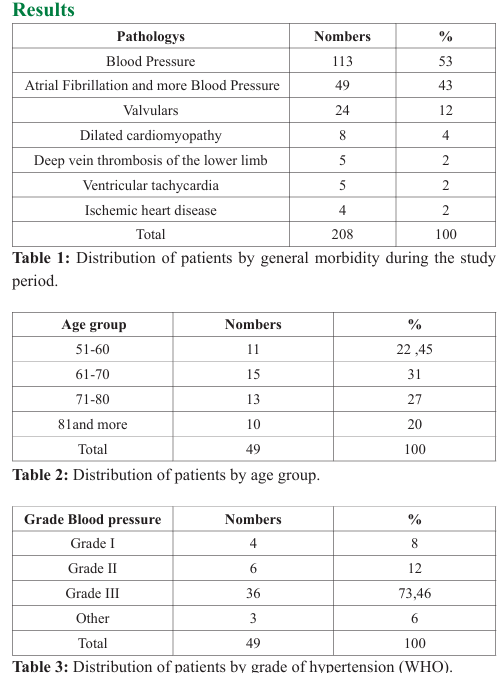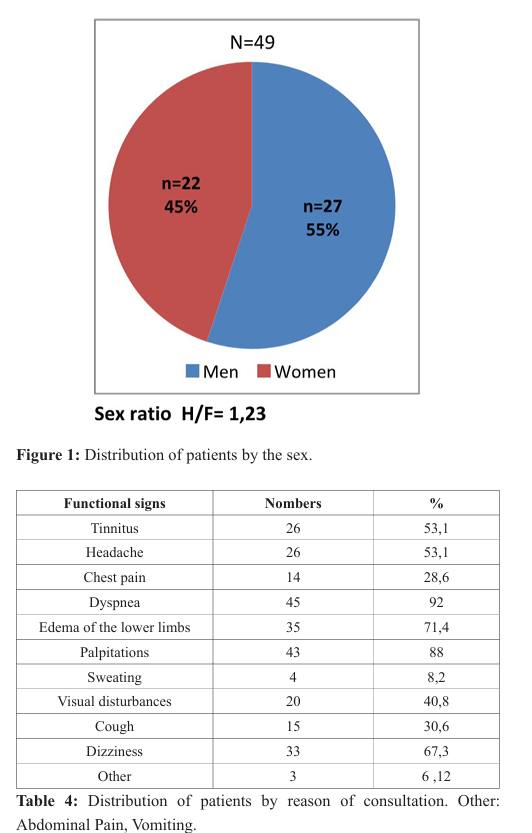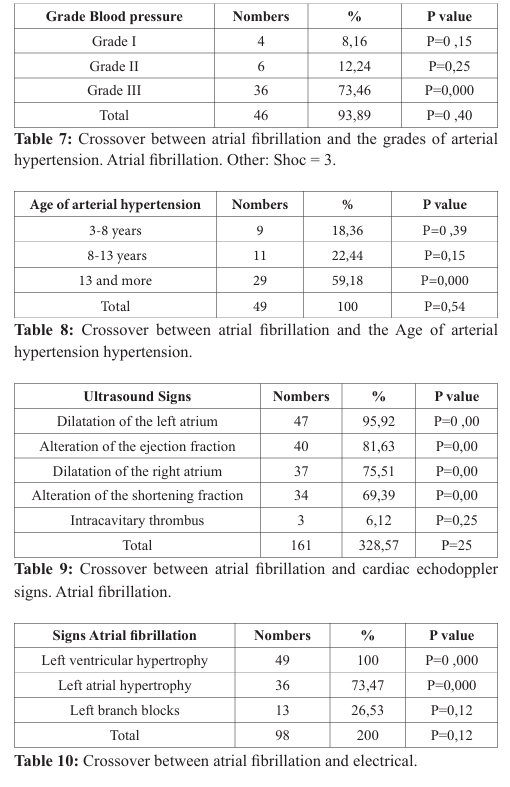Atrial Fibrillation During High Blood Pressure at the Cardiology Department of Ignace Deen National Hospital CONAKRY CHU
Author(s): Samoura Aly*, Camara Abdoulaye, Samoura Sana, Beavogui Mariama, Soumaoro Morlaye, Koivogui Diarra, Doumbouya Mohamed, Barry Ibrahima Sory, Balde El Hadj Yaya, Balde Mamadou Dadhi and Conde Mamady
Cardiac Service Ignace Deen CHU Conakry, Guinea.
*Correspondence:
SAMOURA Aly, Cardiology Department of the IGNACE National Hospital in CHU Conakry, Guinea, Tel: +224 622 104 550/666 753 858.
Received: 05 May 2019; Accepted: 20 June 2019
Citation: Samoura Aly, Camara Abdoulaye, Samoura Sana, et al. Atrial Fibrillation During High Blood Pressure at the Cardiology Department of Ignace Deen National Hospital CONAKRY CHU. Cardiol Vasc Res. 2019; 3(3); 1-4.
Abstract
Summary: Atrial fibrillation (AF) is a supraventricular arrhythmia characterized by anarchic atrial electrical activity with the main consequence of impaired mechanical function of the atria.
Patients and Methods: Descriptive, prospective cross-sectional study conducted over six (6) months, 1stOctumbre 2015 to 31st March 2016. All patients admitted and hospitalized in the department for atrial fibrillation and arterial hypertension were eligible for the study. Sociodemographic, diagnostic and evolutionary data were studied.
Results: The study included 49 patients during the period. There were 27 men (55%) and 22 women (45%), sex ratio H / F = 1.23). The frequency of AF and hypertension was 43%. The average age of our patients was 72.16 years old with extremes of 51-97 years. The most represented age groups were between 61-70 years old, ie 31%. Dyspnea and palpitations were the major symptoms in our sample with frequencies of 45 cases 92% and 43 cases 88% respectively. Heart failure and stroke were complications ie 49 cases 100% and 8 cases 16.33%.
Conclusion: Atrial fibrillation during hypertension is common in the cardiology department of the Ignace DEEN National Hospital mainly related to cavitary hypertrophy. Early discovery associated with effective management of hypertension would prevent or slow the progression of atrial fibrillation in hypertensive patients.
Keywords
Introduction
Atrial fibrillation (AF) is a supraventricular arrhythmia characterized by anarchic and chaotic atrial electrical activity with the main consequence of an impairment of the mechanical function of the atria [1]. Thromboembolic complications, including cerebral and hemodynamic consequences make gravity from the FA.
Around the world, atrial fibrillation affects more than 33 million people and its incidence is increasing [2]. In France 1000 new patients per million inhabitants which represents nearly 5 million people likely to be affected by fibrillation is 1% of the general population. 0.5% of people under 40 years, 5% of people over 65 years old, more than 10% of people over 80 years old and 20-30% of strokes are secondary to atrial fibrillation in Europe [3].
In Canada, nearly 250,000 people suffer from atrial fibrillation [4]. In the last 20 years, hospitalizations for atrial fibrillation have increased by 66% due to the aging of the Canadian population, with an increase in the prevalence of chronic heart disease (CHD) [5].
The mechanism of atrial fibrillation in hypertensive patients remains poorly understood. However, several studies suggest that it is by the alteration of the diastolic properties of the left ventricle and the disruption of the contractile and electrical functions of the atrium that arterial hypertension could occur. High daytime systolic and nocturnal pressure on ambulatory recording could be an interesting predictor [6].
The objectives of this work were to contribute to the study of atrial fibrillation during arterial hypertension, to determine the frequency of atrial fibrillation during arterial hypertension, to identify factors related to the occurrence of fibrillation auricular during high blood pressure and in the end describe the complications of AF during high blood pressure at the cardiology department at the cardiology department of the Ignace Deen National Hospital CONAKRY CHU.
Patients and Methods
This was a prospective, cross-sectional descriptive study lasting 06 months from October 1, 2015 to March 31, 2016. It included 113 cases of hypertension and 49 cases of AF associated with hypertension confirmed at baseline. The ECG of 12 leads and echodopplercardiaque. All hypertensive patients with atrial fibrillation hospitalized at the cardiology department who agreed to participate in the study and performed the cardiac echodoppler, and were not included in this study, All hospitalized hypertensive patients who did not have fibrillation atriale. We analyzed the epidemiological, clinical and paraclinical aspects. These data were analyzed using the software info epi Info 7.0 Windows, Word and Excel 2007. The chi-square test (χ2) was used for the comparison of means with a threshold of significance for a value of P less than 5% (P <0.05).




Discussion
During our study, 208 patients were hospitalized in the cardiology department, among which we counted 113 cases of hypertension (54%). Among the hypertensives we found 49 cases of hypertension and FA is a frequency of 43%. Our results are higher than those found by Nyanga Cyprien et al in 2013 in the same service that reported a frequency of 10.42% [7]. This finding demonstrates that hypertension is the leading cause of morbidity in the service and increased cardiovascular risk factors, including hypertension, age, sex, obesity, sedentary lifestyle, tobacco, and alcohol.
The average age of our patients was 72.16 years old with extremes of 51-97 years. The most affected age group was between 61-70 years old with a frequency of 30, 61% followed by 71- 80 years old with a frequency of 26.53%. Our results corroborate those of CIARONI S and Coll in their study on the predictive parameters of AF in hypertensive patients or the most affected age group was between 80-89 years or 27% [8] .This high frequency of Atrial fibrillation in the elderly is justified by cardiac aging resulting in a change in myocardial structure.
In our study the male predominance was 27 cases or 55% against the female sex of 22 cases or 45% with a sex ratio of H / F = 1.23. Our results are identical to those of CIARONI S et al in their study on the predictive parameters of AF in hypertensive patients [8].
Most of our patients were seen in grade III hypertension (36 cases with a frequency of 73, 46% followed by grade II 6 cases with a frequency of 12.24% and grade I 4 cases with a frequency of 8, 16% Our result is identical to those of CIARONI S and Coll which brought respective frequencies of 72.8%, 18% and 9.2%
[8]. In relation to this prevalence of atrial fibrillation at grade III of hypertension ; Our result is in line with the literature data. Indeed, an increase in blood pressure associated with age increases the risk of the onset of atrial fibrillation and its complications.
In our series, the main functional signs at admission were dyspnoea in 45 cases, ie 92%, palpitations in 43 cases or 88%, IMO in 35 cases, or 71.4%. Our results are superior to those of Nanakan N'GUISSAN who found frequencies of 83.7% and 78.4% respectively.
In his study on Heart Failure and Supraventricular Rhythm Disorder in the Elderly Age. 2009-2010 in Bamako [9]. During our study heart failure was the most common complication in 49 cases with a frequency of 100%, followed by stroke 8 cases or 16.33%. Our results are comparable to those of CIARONI S and Coll in their study on the predictive parameters of AF in hypertensive patients is respectively 95.8% and 15.8% [8] .Cella is explained by the fact that heart failure is the culmination of all cardiac pathologies.
In our series, the increase in the size of the left atrium was the most common abnormality in 47 cases with a frequency of 95.92% followed by the alteration of the stroke fraction of the left ventricle in 40 cases. a frequency of 81.63%. Our results are higher than those of CIARONI S and Coll which found respectively 74% and 26% [8]. This rise in numbers is justified by the fact that HTA has a negative impact on heart cavities.
In our study Left ventricular mass, and left atrium diameter at cardiac duplex were independent predictors of atrial fibrillation with the highly significant P = 0.000. Our results are comparable to those of Paolo Verdecchiaet coll in Italy. Reported a very significant relationship of P = 0.01 [9].
In our series, ventricular and atrial hypertrophy were independent predictors of atrial fibrillation with P = 0.000 highly significant followed by grade II with a significant relationship of P = 0.25. Our results are comparable to those of Paolo Verdecchia et al in Italy. Reported a very significant relationship of P = 0.01 [9].
In our sample, grade III arterial hypertension was highly significant at the onset of atrial fibrillation with P = 0.000. Our results are comparable to those of Paolo Verdecchiaet coll in Italy. Reported a significant relationship of P = 0.05 followed by grade II with a significant relationship p = 0.05 [9].
References
- Da Costa A, Roméyer-Bouchaud C, Bisch L, et al. Atrial fibrillation: Epidemiological issues, definition, nosology, medico-economics. Ann Cardiol Angeiol. 2009; 51: 3-5.
- Sumeet S. Chugh, Havmoeller R, Narayana K, et al. Worldwide epidemiology of atrial fibrillation: a Global Burden of Disease 2010 Study. Circulation. 2014; 129: 837-847.
- High authority of health Atrial Fibrillation. Saint-Denis. 2007; 3-6.
- Scavée C. Ablation of Atrial Fibrillation Experiment of a Reference Center Bordeaux. Octombre. 2004; 276.
- Sanofi A Ventis Multaq. Dronedarone approved in Canada for the treatment of atrial fibrillation. Paris A. 2009; 2.
- Bernard JY, The Arm M Chauvet J, OdiAsasamoi M, et al. General etiology of rhythm disorders and conduction observed in Abidjan (first part). Medicine of Black Africa. 1972; 19: 87.
- Nyanga Cyprien G. Prevalence of atrial fibrillation in the cardiology department (thesis) of the IGNACE DEEN national hospital. 2013.
- Ciaroni S, Coll. Study on the predictive parameters of AF in hypertensive patients Collection Street of the University of Geneva Medicine and Hygiges. 2000; 449-512.
- Nanakan N'GUISSAN. Heart failure and supraventricular rhythm disorder in the elderly (thesis) in the cardiology department of Gabriel Toure Hospital, Bamako. 2OO9-2010; 72.
- Paolo Verdecchia, Gian Paolo Reboldi, Roberto Gattobigio, et al. Atrial fibrillation on hypertension Prediators and results in 2003 Italy. American Heart Association, Inc. 2003; 223.